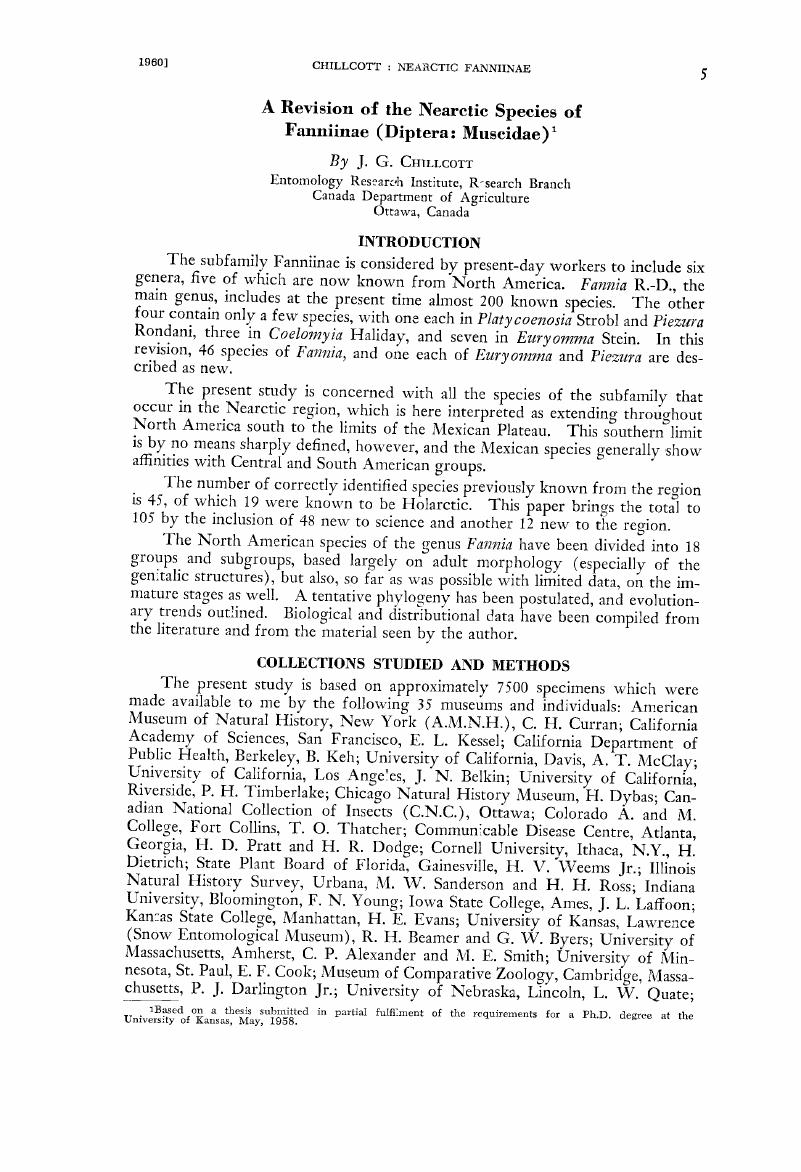Crossref Citations
This article has been cited by the following publications. This list is generated based on data provided by Crossref.
Uebel, E. C.
Schwarz, Meyer
Miller, R. W.
and
Menzer, R. E.
1978.
Mating stimulant pheromone and cuticular lipid constituents ofFannia femoralis (Stein) (Diptera: Muscidae).
Journal of Chemical Ecology,
Vol. 4,
Issue. 1,
p.
83.
Uebel, E. C.
Schwarz, Meyer
Menzer, R. E.
and
Miller, R. W.
1978.
Mating stimulant pheromone and cuticular lipid constituents ofFannia pusio (Wiedemann) (Diptera: Muscidae).
Journal of Chemical Ecology,
Vol. 4,
Issue. 1,
p.
73.
HUNTER, D. M.
1979.
SWARMING BEHAVIOUR OF THE LESSER HOUSE FLY, FANNIA CANICULARIS, IN BRISBANE.
Australian Journal of Entomology,
Vol. 18,
Issue. 1,
p.
27.
Dindonis, Liene L.
and
Miller, James R.
1981.
Onion fly and little house fly host finding selectively mediated by decomposing onion and microbial volatiles.
Journal of Chemical Ecology,
Vol. 7,
Issue. 2,
p.
419.
NISHIDA, Kazumi
2002.
Two new species (Diptera : Fanniidae) collected in the Imperial Palace, Tokyo, Japan.
Medical Entomology and Zoology,
Vol. 53,
Issue. Supplement2,
p.
173.
NISHIDA, Kazumi
2003.
Studies on the species of Fanniidae (Diptera) from Japan V. A new species belonging to the carbonearia subgroup and three newly recorded species from Japan.
Medical Entomology and Zoology,
Vol. 54,
Issue. 1,
p.
97.
NISHIDA, Kazumi
2004.
Studies on the species of Fanniidae (Diptera) from Japan VI. Two new species closely related to Fannia lineata (Stein) and two newly recorded species from Japan.
Medical Entomology and Zoology,
Vol. 55,
Issue. 4,
p.
269.
Gerry, Alec C.
and
Mullens, Bradley A.
2006.
AdultFannia benjaminiComplex (Diptera: Muscidae) Activity in Southern California and Use of CO2as an Attractant.
Journal of Medical Entomology,
Vol. 43,
Issue. 3,
p.
467.
Gerry, Alec C.
and
Mullens, Bradley A.
2006.
Adult <I>Fannia benjamini</I> Complex (Diptera: Muscidae) Activity in Southern California and Use of CO<SUB>2</SUB> as an Attractant.
Journal of Medical Entomology,
Vol. 43,
Issue. 3,
p.
467.
IWASA, Mitsuhiro
2007.
Review of the flies (Diptera) associated with animal dung and human feces in Japan.
Medical Entomology and Zoology,
Vol. 58,
Issue. 3,
p.
155.
Velásquez, Y.
Martínez-Sánchez, A.
and
Rojo, S.
2013.
First record of Fannia leucosticta (Meigen) (Diptera: Fanniidae) breeding in human corpses.
Forensic Science International,
Vol. 229,
Issue. 1-3,
p.
e13.
Pont, Adrian C.
2013.
The Fanniidae and Muscidae (Diptera) described by Paul Stein (1852-1921).
Zoosystematics and Evolution,
Vol. 89,
Issue. 1,
p.
31.
Perez, Anne E.
Haskell, Neal H.
and
Wells, Jeffrey D.
2014.
Evaluating the utility of hexapod species for calculating a confidence interval about a succession based postmortem interval estimate.
Forensic Science International,
Vol. 241,
Issue. ,
p.
91.
Zhang, Congcong
and
Gerry, Alec C.
2015.
Laboratory Colonization, Life History Observations, and Desiccation Tolerance of the Canyon FlyFannia conspicua(Diptera: Fanniidae).
Journal of Medical Entomology,
Vol. 52,
Issue. 4,
p.
532.
Wang, Ming-fu
LI, Wei
Zhu, Weibing
and
Zhang, Dong
2016.
Review of the Fannia postica-group Chillcott, 1961 of the genus Fannia Robineau-Desvoidy, 1830, with description of two new species from the Palearctic and Oriental regions (Diptera, Fanniidae).
ZooKeys,
Vol. 598,
Issue. ,
p.
113.
Yan, Li-ping
Xu, Wen-tian
Wang, Ming-fu
and
Zhang, Dong
2019.
A new species of Fannia (Diptera, Fanniidae) from Yunnan, China.
ZooKeys,
Vol. 862,
Issue. ,
p.
153.
Prado, Aline M.
Madeira-Ott, Taís
Grella, Maicon D.
and
Thyssen, Patricia J.
2020.
First description of the immature stages of Fannia sabroskyi Seago, 1954 (Insecta, Diptera, Fanniidae).
Acta Tropica,
Vol. 212,
Issue. ,
p.
105687.
Yang, Li
Ren, Lipin
Shang, Yanjie
and
Zhang, Changquan
2021.
Progress on reproductive modes of sarcosaphagous flies.
Journal of Asia-Pacific Entomology,
Vol. 24,
Issue. 3,
p.
731.
Murillo, Amy C
Hubbard, Caleb B
Hinkle, Nancy C
Gerry, Alec C
and
Messenger, Matthew
2021.
Big Problems With Little House Fly (Diptera: Fanniidae).
Journal of Integrated Pest Management,
Vol. 12,
Issue. 1,
Ibáñez-Bernal, Sergio
and
Sandoval-Ruiz, César A.
2021.
Los enviados de Belcebú: Moscas y mosquitos (Diptera) exóticos con interés médico y veterinario en México.
CIENCIA ergo sum,
Vol. 28,
Issue. 1,
p.
1.



